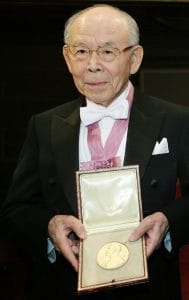Born in Japan’s Kagoshima Prefecture, after his schooling Akasaki took a series of research positions with industry and universities. His goal: to produce cheap, stable, and (especially) bright blue lasers and LEDs. Why? White light can be created by mixing red, green, and blue (“RGB”). Red and green lasers/LEDs had been perfected, but adding blue to the mix at similar brightness levels would enable cheap and efficient lighting and projection. Also, blue lasers would enable higher-density information storage and retrieval.
When Isamu Akasaki, Hiroshi Amano, and Shuji Nakamura “produced bright blue light beams from their semiconductors in the early 1990s, they triggered a fundamental transformation of lighting technology,” said the Royal Swedish Academy of Sciences in 2014. “Red and green diodes had been around for a long time but without blue light, white lamps could not be created. Despite considerable efforts, both in the scientific community and in industry, the blue LED had remained a challenge for three decades. They succeeded where everyone else had failed.” Efficiency was the key: measured in lumens per watt of electricity, incandescent light bulbs produce 16 lumens per watt. Fluorescent lights reach about 70; LED bulbs have reached 300. They last much longer too: incandescents typically burn out after about 1,000 hours of use; fluorescents after about 10,000 hours. LED lights last around 100,000 hours (well over 11 years of continual operation), which life isn’t reduced by cycling its power on and off. As for information storage and retrieval, consider why the Blu-Ray disc player is called that.

The occasion for the Royal Swedish Academy of Sciences to write about the three men was it awarding them the 2014 Nobel Prize in Physics “for the invention of efficient blue light-emitting diodes which has enabled bright and energy-saving white light sources.” While “incandescent light bulbs lit the 20th century,” they concluded, “the 21st century will be lit by LED lamps.” Akasaki was also elected to the U.S. National Academy of Engineering in 2008, and awarded the Millennium Technology Prize in 2006, the Kyoto Prize for Advanced Technology in 2009, IEEE’s Edison Medal in 2011, the Draper Prize in 2015, and the Queen Elizabeth Prize for Engineering in 2021. Meanwhile, the royalties on Akasaki’s patents paid for the construction of the Nagoya University Akasaki Institute, which opened in 2006. “Once you have resolved to accomplish something,” Akasaki said, “never give up.” He died April 1 from pneumonia. He was 92.
